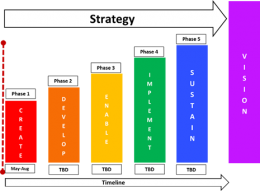 Where are you going?
Where are you going?
A successful change or transformation programme has many components. However, unless leadership provides clarity on what a programme seeks to achieve, there is unlikely ever to be more than loose directional alignment and half-hearted commitment.
Many organisations, including churches, have no clear framework within which they dream or deliver, preferring to describe their strategy in terms of the collection of (often good) activities that they undertake. But these may not flow from a clearly articulated vision, supported by a top level strategy, through to a set of plans, delivered by highly motivated, enrolled and equipped people.
Be specific, succinct and clear
Vision statements (the ‘where’) should be future-based and inspire, and give direction to members of the organisation, rather than necessarily to the external community. They should be inspirational, clear, memorable, and concise. Unfortunately, many vision statements are quite the opposite and are a muddle of mission statements and long-winded, non-specific descriptions.
As part of, or in addition to, a vision statement, some form of specific measurement can be very helpful – ‘What gets measured gets done’. Many leaders prefer not to have anything against which to measure their performance, preferring the apparent benefit of not being on the hook for anything, thereby eliminating any prospect of ‘failure’. The success of the organisation is dependent on leaders who are prepared to take a stand for something bigger than themselves, despite not knowing exactly how they will get there as they set off on the journey.
How will you get there?
Strategy is the way in which the organisation will go about unlocking the vision. Priorities, plans, resources and many, many other things then flow from the vision and strategy to ensure ‘top to bottom’ and ‘bottom to top’ alignment. With clear alignment, clear line of sight, and everyone knowing and being valued for their part in the strategy, the wider team then sets about making it happen.
What is our starting point?
Having defined a clear, exciting future state, an honest, sober and robust assessment of the ‘now’ state is essential. The catch 22 is that without great leadership, the assessment can become more of an exercise in describing what the leaders wished their organisation, whether church or wider ministry, were like, rather than actually confronting the reality. Whatever the current state of the organisation, ‘it is what it is’. Only by getting straight about what it is does it become possible to create and deliver extraordinary breakthrough. Get this significantly wrong, and the path to failure has already been laid.
Process
Some form of Strategic Planning Process with an accompanying Strategic Plan are essential components of significant change or transformation. The following diagram is an example of a top level ‘Vision led Strategy’, which is underpinned by a set of plans, and a linked organisational design that will deliver the strategy and ultimately unlock the vision.

The Strategic Planning Process and associated development and delivery of the Strategic Plan can be supported by ‘Kotter’s 8 Step Process for Leading Change’ which describes a helpful model for understanding and managing change. We will cover these 8 steps over the coming weeks.
